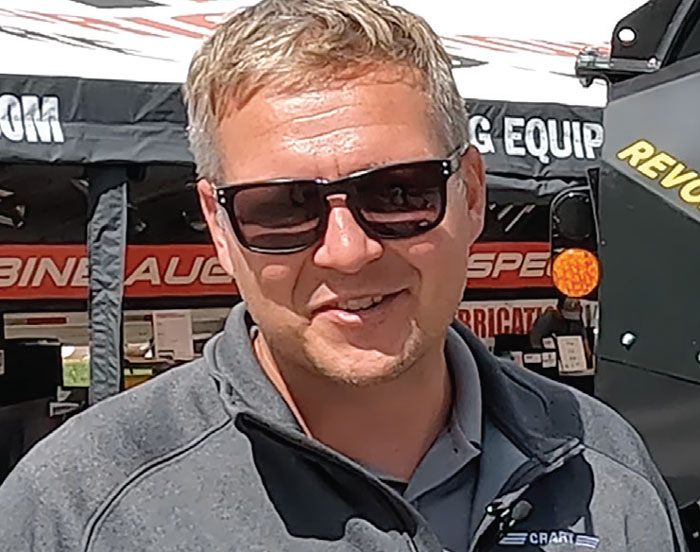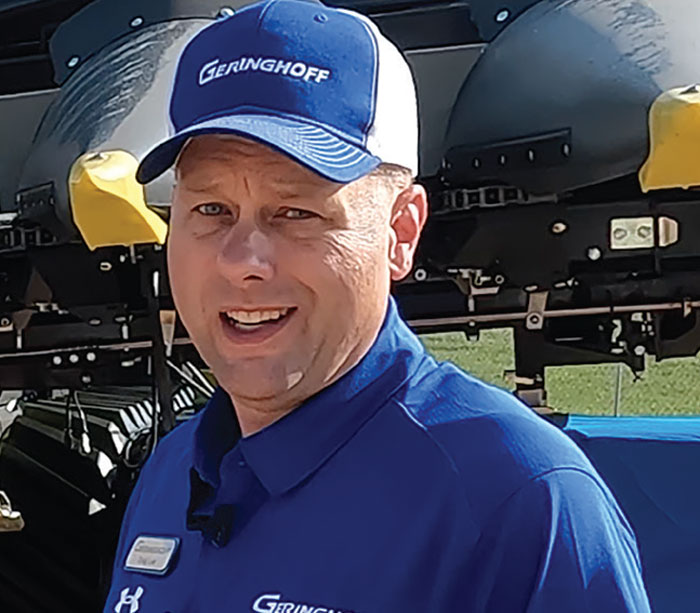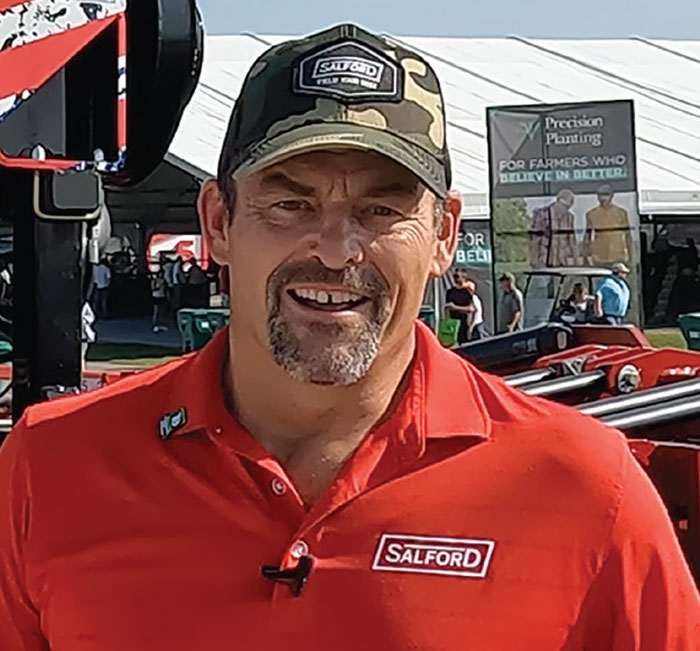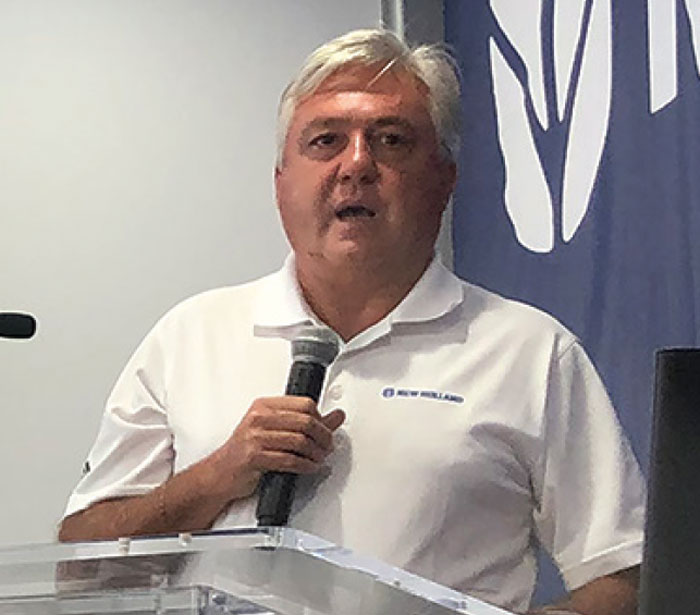2024 is set to be a slower year than the last 3. Dealer lots are filling back up, manufacturing backlogs are clearing up, and farmers are starting to pull back on their equipment purchases. The term “shallow trough” came up a few times at this year’s Farm Progress Show, signifying the belief that the upcoming slowdown will be a small dip but nothing like what was seen in 2013-15.
With the year coming to a close soon and a decent amount of uncertainty on the horizon, Farm Equipment editors spent much of their time at the Farm Progress Show taking the temperature of ag equipment manufacturers’ sentiments for 2024. Results varied, showing that while the industry knows market changes are coming, it could affect everyone differently.
2024 Ag Economy & Farmer Success
Claas Senior Vice President Americas Eric Raby is feeling better about 2024’s ag economy than he was earlier this summer. He’s still worried about interest rates, but he sees farmers remaining resilient and discussing their future equipment needs.
“The resilience of agriculture is going to continue to shine through,” says Raby. “The market coming up this next year is probably going to be a little bit down, but there’s a lot of good things that are happening. Input costs are not as bad as they were, at least volatility-wise. Commodity prices still are going to be one of those things that we need to take a look at, but one thing that does concern me a little bit is interest rates. We’re really hearing a lot of that from farmers and from our dealers, too. I’m feeling better about 2024 now than I was probably 45 days ago.

For Kenton Johnson, Crary product specialist, most concerns for 2024 center around water. Photo by: Ben Thorpe
“Farm shows maybe give you a false sense of optimism, but I would say the crowd was good. The engagement and the interaction with people is good, and they’re talking about, ‘In the future, I want to have more technology,’ or ‘I want more capacity.’ So there’s still that draw there, and that reassures me. You could say, ‘Well, the market’s going to be up, it’s going to be down.’ The truth lies somewhere in the middle. But for right now, again, I’m feeling a little bit better that if we do go into a trough as has been written before, it’ll be a shallow one.”
Crary Product Specialist Kenton Johnson, when looking at 2024, is most concerned about water availability for next year’s crop — not just in the context of his company’s own equipment but also for how it might impact equipment demand. Among other things, Crary manufactures air reel systems, cutting systems and ditchers.
“One, our concerns are mostly addressing water, so we’ve kind of had some dry spells,” Johnson says. “It seems like we’re past that, but that would be the thing. If we run into that next year, that’s a problem going forward, where it’s not just from us selling equipment, but also from the standpoint of farmers. Maybe they don’t have a good crop because it’s been too dry. And so they don’t have money to get that equipment that they need to address those issues in their fields.”
Vice President of Agriculture Sales at JCB Shane Coates notes one possible concern for JCB dealers — aside from interest rates and inventory management — is fluctuating commodity prices. JCB manufactures tractors, telehandlers and wheel loaders, among other products.
Ukraine: Peace, Demand, Tires?
Though the war in Ukraine may now feel like a permanent fixture in global news, CEAT Specialty Tires President of North American Operations Ryan Loethen is counting on it ending next year. Not only that, but he believes it will trigger a wave of equipment demand that will fix a current glut in the tire market.
“My biggest concern, and I’ll be frank, is that there’s an excess of tires in the market right now,” he says. “That happened because one company I won’t name decided to send 2 years of product in at once. And that’s coupled with the war in Europe. Ukraine, Belarus, Russia are major consumers of ag tires. Companies like Michelin, Firestone who use those tires in Europe aren’t selling the tires in Europe because there’s nowhere to go with them. So they’re staying here. It’s coupled with a decrease of OEM purchases from Eastern Europe that would normally consume those tires, and they’re produced in the U.S. and shipped over.”
Loethen views this as a “6-month situation,” and forecasts billions in aid arriving in Ukraine to rebuild the country, including its agriculture market.
“They’re going to buy tractors — a ton of tractors,” Loethen says. “That’s going to consume everything that John Deere, Case and AGCO can make, and they’re manufactured here. It’ll suck the tires out of the U.S. market coupled with the tires in Europe staying in Europe, not being shipped here.”
“There’s always this concern of, ‘Where’s the corn or soybeans produced in the United States and have we banked on the heavy corn back when corn was $6-7 a bushel or more?’” he says. “And now it’s coming back down to that $4-plus range. Dealers look at the data and think, ‘Hey, these are record predicted yields or very close to that.’ They’ve probably eased off that a little bit with some of the heat lately, so maybe the yields won’t be quite that heavy. You’ve seen the commodity price fluctuate a little bit back and forth on that.”
Farmer succession is something Craig Lee, Geringhoff director of sales, sees as a pain point for dealers in 2024, though he has faith they’ll find a solution.
“I think farmer consolidation is still an issue, and I think there’s always going to be some concerns as the farmer numbers go down, the machine size goes up, and then the secondary market for the big machines — what do they do with that?” Lee says. “But to some degree, that’s always been a concern as long as we’ve had the equipment business, and dealers seem to figure it out.”
Interest Rates
The majority of manufacturers brought up interest rates at some point in discussing their forecasts, with responses ranging from serious concern to “it is what it is.”
Degelman National Sales Manager Kyle Klapper says the company has been working to offer more creative financing solutions for its dealers and carry more cost for them. Degelman manufacturers tillage implements, rippers, harrows and land rollers.
“We offer a 9-month DLL financing option with no interest/no payment, but we also offer in-house internal terms where we’ll carry the cost of the equipment on our books to a specific due date,” Klapper says. “So we’re delivering equipment for the last quarter-and-a-half, and that equipment won’t be due until Oct. 1 when we roll into our spring early order program, and we’ll have terms out until April 1. We’re trying to carry that cost for the dealer until the season of use to get that sold on the dealer side.”
“The resilience of agriculture is going to continue to shine through…”
Salford Group is similarly trying to take some risk for their dealers, says Director of Business Development David Webster, as he forecasts the biggest pain point for 2024 will be managing inventory. Salford Group manufactures tillage and application equipment.
“Dealers are expecting a slowdown — everyone’s trying to figure it out,” he says. “We have been offering some programs with terms to try to take some of that risk out of it. But those terms with interest rates, of course, are getting much more expensive than they were a year or 18 months ago. So that’s a balancing act.”
Case IH Vice President for North America Kurt Coffey makes an important distinction about interest rates for 2024: he’s aware of them, but not worried about them.

Craig Lee, Geringhoff director of sales, says dealers will still find ways to handle farmer consolidation in 2024. Photo by: Ben Thorpe
“This would be like my father calling me worrying about whether or not it rained,” Coffey says. “He taught me at a young age: we manage what we manage, and in that example we take what the good Lord gives us. So am I worried about them? No. Am I aware of them? For sure. That impacts our customers. That impacts our dealers. We actually take a step back and say how can we overlay these macro situations and be a good partner to our dealers, and how can we make sure that we have the right levers in place such that our customers can still partner with us.”
Growing Interest in Reduced Tillage, Cover Crops
Several manufacturers are leaning into the realm of reduced tillage and cover cropping, which they see gaining adoption in North America. Schlagel Manufacturing Regional Sales Manager Jonathan Spence says the company is seeing new faces approaching strip-till equipment. Schlagel Manufacturing produces strip-till machines, closing wheels and gopher machines.
“Strip-tilling is getting to be hot,” says Spence. “There’s a lot of folks who are looking at it that never looked at it before, especially with soybeans, and people are starting to look at that crop a little more. We have the capability of getting out of that 20-inch row center. It’s really encouraging for us because we’re going to be sitting in a pretty good spot for what’s hot right now.”

Dealers are expecting a slowdown in 2024, says David Webster, Salford Group director of business development. Photo by: Ben Thorpe
Vulcan Equipment Vice President Don Slagel agrees, saying he’s seen a steady increase in adoption. Slagel specifically thinks the industry needs to be more cognizant of conservation ag payments being made to growers. Vulcan Equipment manufactures strip-till equipment and harrows.
“Probably the two biggest things would be the steady rise in strip-till and, as we look at what the government is doing to try to get people to turn toward conservation tillage, that could be one of the bigger things,” Slagel says. “We’ve got to figure out how to capitalize on it, possibly by helping get the word out there.”
When asked where he’s bullish for wholegoods sales in 2024, Great Plains Ag Division President James Shurts says, “Cover crops, cover crops and potentially cover crops.” Great Plains makes tillage implements, planters, drills and fertilizer spreaders.
The Shortline-Only Dealer Niche
Don Slagel, vice president of Vulcan Equipment, says the company is looking for more shortline-only dealerships to carry its equipment. Even when Vulcan is able to get into larger, more “brand-pure” dealerships, he says, the business model doesn’t favor its type of equipment.
“What we find with the dealers we’ve worked with or have tried to work with, if we can find our small shortline dealers, for the most part, they are going to make way better dealers,” he says. “Because first of all, John Deere doesn’t even want a shortline company on its dealers’ lots. I’ve heard that many times. But we’ve been selling through Western Equipment down in the Panhandle of Texas, and they’ve got stores in Oklahoma. They’re a large John Deere dealer, and they sell Landoll, which John Deere doesn’t like because they directly compete. But they’re a big enough John Deere dealer, and the farmers come in and they want to buy this stuff, and John Deere doesn’t offer it. So I guess they're kind of allowing it.” The hang-up for shortlines and for Vulcan Equipment in particular, according to Slagel, is that the dealers’ sales model focuses on the expensive, high-horsepower tractor and ripper in this situation, which isn’t required for strip-till farming.
“Those dealers want you to come in and buy a $500,000, 500-horsepower tractor and a big ripper because that’s where their sales are at,” Slagel says. “If you come and buy this strip-till equipment and go to strip-till, you don’t need that. I don’t really get the most positive feedback from those companies. We’re really going to be looking more and more for shortline dealers. Some of your shortline dealers offer the precision equipment from Precision Planting, that type of stuff. I think those are going to make our best dealers.”
“You’re seeing more of our box drills sold in the non-traditional box drill markets than we've ever seen,” Shurts says. “This is just from the standpoint of the versatility of the product, the cost point, the price point of entry of the product.
“And you’re starting to see just the capabilities of guys who can offset really expensive planters with a box drill to do their cover crops and companion seeding and narrow-row soybeans all in one unit. We’re getting more abreast in all markets pushing forward with a much more strategic soil health solution.”
Staff Shortages, and Not Just Techs
Several manufacturers were concerned about their dealers’ employee retention for 2024. For Spence, it goes beyond the universal tech shortage: his area of concern is salespeople.
“Dealerships have a hard time hanging on to guys,” he says. “It’s not like it used to be, where there was a guy who’d stay there for 30 years. It’s a cutthroat world, and we have a lot of turnover, where we’ll have a guy that we get really familiar with and then 6 months later he’s gone.

New Holland is looking at expanding its tech stack in 2024, says Brand President Carlo Lambro. Photo by: Ben Thorpe
“A lot of times you’ll get lucky, and he’ll just move to a different dealer network. He’ll take the same mentality with him there, and you [the manufacturer] pick that dealer up. It’s a challenge to relationships when you cover a large territory like that. You can’t be everywhere all the time.”
New Holland Agriculture Brand President Carlo Lambro lists labor shortages as the key issue New Holland dealers will face in 2024 — as well New Holland itself.
“For me, one of the big problems we see in our dealers — not only in our dealers but in all the industry — is more and more a lack of product specialists and technicians, which is always hard to find,” Lambro says. “There is a lot of demand for labor, and to find skilled people on the technical side is difficult — not only for us but also for our dealers.”
Supply Chain: The Worst is Behind Us
After 3 solid years of hearing the word “supply chain” around every corner, many manufacturers feel they’re finally getting over this hump.
Part of Harvest International’s efforts to overcome supply chain issues included bringing some aspects in-house, according to Sales Director Dustin Friesen. Harvest International manufactures planting and tillage equipment.
“We’ve got a lot more machining capabilities, things that we can rapidly fabricate,” he says. “We’ve had to look at some different suppliers or even take on multiple suppliers so that there’s some contingencies there. We feel like we’re in a much better position, but it’s been through a lot of hard work on our purchasing and engineering departments to get to a place where we’re much more confident now than we were a year ago.”
“Dealers are expecting a slowdown — everyone’s trying to figure it out…”
For Schlagel Manufacturing, making all its own components had been viewed as a poor decision by some — having all their eggs in one basket — but provided a powerful level of control when the pandemic hit, says Spence.
Andy Unverferth, marketing manager at Unverferth Manufacturing, says the company is looking forward to getting production back on track in 2024. Unverferth Manufacturing sells strip-till, grain handling and fertilizer application equipment.
“The last 2-3 years with the challenges after COVID, we’ve been figuring out how to navigate lead times from suppliers, whether it’s hydraulic cylinders or electronics,” Unverferth says. “We feel we have finally had that process nailed in. So the lead times are a little bit longer from some suppliers, but we’re forecasting out further, so we’re realizing the gains from that, and we will be realizing that in 2024.”
Order backlogs are improving but not totally gone, says Adam Reid, vice president of sales and marketing at Versatile. While it remains one of Versatile dealers’ pain points — and it’ll be a long time before they stop looking over their shoulders regarding supply chain problems — he says Versatile’s forecasts are improving, and 2024 will see the company “smooth out” its remaining orders. Versatile manufactures tractors, sprayers and tillage tools.
“The biggest pain point for us is the backlog of orders that we’re still working through — it is far longer than I care to admit,” Reid says. “We’re trying to keep the lines of communication open with those dealers as we still struggle with the tail end of supply chain challenges, being able to give them better dates on when the equipment will be ready. For example, in our tillage line, we’ve refined that. We’ve ironed out all of the supply chain problems, so we can now give them firm dates on when those units will be available. That’s comforting to them, comforting to us that they know when their units are coming instead of finding out at the last minute that a wiring harness was late on a tractor.”
2024 Equipment Opportunities
For Lambro, optimism in 2024 is connected to technology, where he sees New Holland catching up in some categories.
“2024 should be the year where we will really start to be very competitive on our tech stack. It’s not a secret a couple of years ago probably when we talked about the tech stack, we were a little bit behind in terms of our features,” Lambro says. “We were excited about some products, some others not so much.
“But in our trajectory, 2024 should be the year where the technology stack is going to completely bundle with what we call the great iron, and we’ll be able to provide a full, competitive product from A to Z, including connectivity, which today we are already doing. Also, we are only covering some product ranges, not all. 2024 should be the year of the majority of launches of tech features for our products.”
“The biggest challenges facing farmers are all based around output and productivity…”
Coffey mentions replacement demand with an aging fleet and the benefits of embedded technology as his bullish sentiment for 2024 equipment sales. He also looks to high-speed planting technology, which he feels still has room for growing adoption in the market.
“High-speed planting technology is certainly a main staple to hit the planting window, and a lot of the market still has not upgraded to high-speed planting,” he says. “Regardless of the macro trends, I’m pretty bullish there.”
Improving performance and increasing output will be important for growers in 2024, according to Kuhn Krause Product Manager Peter Goodge.
“The biggest challenges facing farmers are all based around output and productivity,” Goodge says. “So whichever piece of equipment is going to allow a farmer to work more acres in a given period of time or just give more units of output, whatever that is in a given period of time, that’s where farmers are going to trend toward. The other thing that we see is on the technology side with precision, and that’s output as well, right? If you are not overlapping with a piece of tillage equipment, if you are optimizing the path of a baler or a rake around the field, you’re increasing precision, minimizing waste, increasing output overall.”
Goodge considers tillage the final frontier in terms of tech integration with ag equipment — something he’s excited about in the future, saying, the technology has “been on planters, sprayers, fertilizer spreaders, moving into what was dumb iron and turning it into smart iron.”






